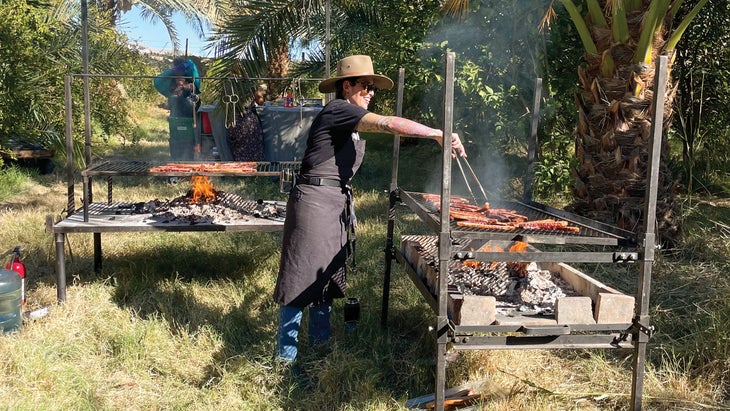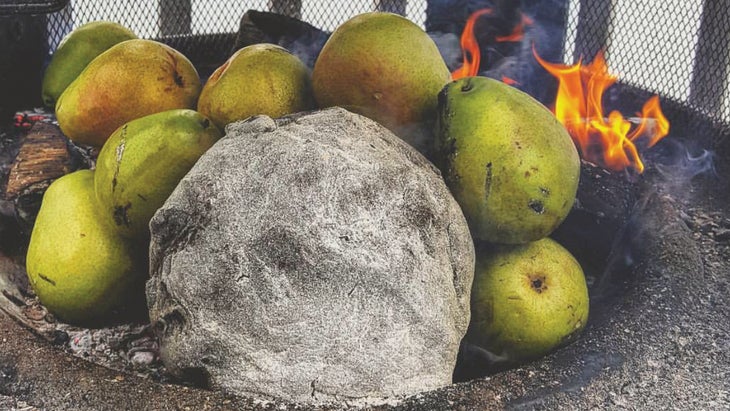San Diego chef never slows down. You might just as easily find the Top Chef , James Beard Award semifinalist, and founder of traversing the border towns of Mexico for her upcoming cookbook, Borderlands, or exploring recipes with Selena Gomez on the Food Network. But when Zepeda seeks solace, she grounds herself in simple outdoor grilling and smoking.
“Outdoor cooking is a ritual I will never get tired of. It keeps me connected to the earth,” she says. “I always want to take my shoes off. I’m very feral when it comes to cooking outside.” From smoked pan sauces to the pit cooking of her Mexican ancestors, Zepeda falls back on a few basic techniques that can work for anybody.
Brine the Yucatán Way
Zepeda preaches that the secret to any good cookout is bold seasoning. She often turns to the soul-stirring flavors of the Yucatán. When prepping her famous cochinita pibil—Yucatán-style slow-roasted pork—she typically uses one of the region’s great sauces: red recado. This concentrated paste features a flurry of herbs and spices, including black peppercorns, coriander, cloves, cumin, garlic, ground annatto seeds, and Mexican oregano. The juice of sour oranges—a more acidic counterpart to the sweet oranges found in the States—tenderizes meats like pork and chicken. (If you can’t find sour oranges at your local Mexican market, Zepeda suggests incorporating limes and green, underripe oranges to achieve the same tartness.)
Use Banana Leaves in Place of Foil
Zepeda likes to use banana leaves to substitute for aluminum as a cooking wrap. Sustainable and versatile, the large, waxy leaves are popular around the world for cooking foods like Puerto Rican pasteles (tamale-like packets) and North African kenkey (fermented corn pouches). The leaves retain moisture and lend a vegetal, earthy note to the finished dish. “I call it green flavor, like if chlorophyll could talk to us,” Zepeda says.
She prefers using fresh leaves (get them at any good Mexican market), pointing out that frozen ones are trickier to handle and can lack flavor. She toasts them until they’re soft and pliable, then cuts them into squares, circles, or strips.

Encase Fish and Vegetables in Salt
Zepeda pairs a classic method of roasting whole fish or veggies inside heaps of salt—when baked, the salt forms a hard shell, steaming whatever’s inside—with live fire cooking. She prepares the base with a 50/50 mixture of kosher salt and masa harina, a Mexican ingredient made from ground corn that’s rendered more alkaline using a process called nixtamalization. She gradually adds water until the combo has the consistency of wet sand, then encases potatoes, beets, celery root, and other vegetables. The briny packet is placed on coals heated to between 300 and 400 degrees Fahrenheit and cooked for 90 minutes.
Whip Up a Smoky Pan Sauce
Ash from an active fire may seem like an unlikely ingredient, but Zepeda often incorporates its smoky, slightly bitter notes into dishes. Her technique is simple: “I’ll drop a cast-iron on the embers to sear a steak. The ash in the air goes into the pan and becomes part of a delicious smoked-butter steak sauce.”
Simulate Pit Cooking on Your Grill
Traditionally, cochinita pibil consists of a large cut of pork, cooked in a pib or underground oven, where it slow-roasts and smokes for hours. Zepeda says you can get similar results from a metal wood-chip box and your outdoor grill. Filled with aromatic chips like hickory or mesquite and placed on top of hot coals, the box ensures that the chips burn slowly, gently smoking the pork until it’s done. It takes hours, not minutes. The target internal temperature is between 145 and 160 degrees.

Outdoor Cooking Essentials
Five must-have ingredients, along with a favorite dish
Whether Zepeda is cooking in a kitchen or outdoors, she’s careful to balance each dish with salt, fat, acid, and heat. Here are her staple ingredients, and a cookout dish her family can’t live without.
Salt: Rule number one for Zepeda: don’t cook without salt. When she’s on the go, she always packs two types, Diamond Crystal kosher for cooking and Maldon (a British sea salt) for finishing.
Oils: Zepeda opts for a neutral oil, such as avocado or grapeseed, preferring the high smoke point. But she will use a peppery, quality olive oil to tie dishes together. Her favorite finishing oil is Olio Colpalombo.
Salsa macha: One of Mexico’s oldest and most revered sauces, salsa macha is made with a variation of dried chiles, garlic, and nuts, all fried in oil. Described by Zepeda as “earthy yet bright, sweet, spicy, and crunchy,” the versatile sauce can be used in marinades or as a drizzle.
Something tart, something sweet: For zing, Zepeda uses lemons, limes, or vinegar—and sometimes all three. Honey and brown sugar are her go-to sweeteners.
Chicken wings: Zepeda’s kids love it when she grills chicken wings outside. A fan of Chinese takeout, she has modified simple salt and pepper wings by enhancing them with salsa macha. When everybody’s craving more traditional wings, she turns to her own rendition of buffalo sauce, made with salsa huichol, which she compares to Tapatío or Valentina.


